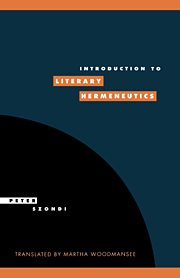Book contents
- Frontmatter
- Contents
- Foreword by Joel Weinsheimer
- Translator's preface
- Chapter 1 Introduction
- Chapter 2 Chladenius, I
- Chapter 3 Chladenius, II
- Chapter 4 Chladenius, III
- Chapter 5 Chladenius, IV
- Chapter 6 Meier, I
- Chapter 7 Meier, II
- Chapter 8 Ast
- Chapter 9 Schleiermacher, I
- Chapter 10 Schleiermacher, II
- Afterword by Jean Bollack
- Index
Foreword by Joel Weinsheimer
Published online by Cambridge University Press: 14 December 2009
- Frontmatter
- Contents
- Foreword by Joel Weinsheimer
- Translator's preface
- Chapter 1 Introduction
- Chapter 2 Chladenius, I
- Chapter 3 Chladenius, II
- Chapter 4 Chladenius, III
- Chapter 5 Chladenius, IV
- Chapter 6 Meier, I
- Chapter 7 Meier, II
- Chapter 8 Ast
- Chapter 9 Schleiermacher, I
- Chapter 10 Schleiermacher, II
- Afterword by Jean Bollack
- Index
Summary
What explains the persistence of hermeneutics? The broad-based resurgence of interpretation theory typified by Martha Woodmansee's translation of Peter Szondi's Introduction to Literary Hermeneutics is occurring precisely at the time when it might seem that hermeneutics, with theory generally, should be fading slowly over the horizon. During the seventies and eighties, talk about the “hermeneutic mafia” at Yale apparently identified hermeneutics with deconstruction. Yet hermeneutics seems to have survived the passing not only of structuralism but poststructuralism too. Besides retaining its longstanding foothold in theology, jurisprudence, and history, hermeneutics has in recent times seen the efflorescence of new “interpretivist” movements in political science, anthropology, rhetoric, and even economics. These movements have marked the expansion and indeed globalization of hermeneutics to the point that it is now perceived to comprehend all the human sciences and (after Kuhn) the natural sciences as well.
The fact that hermeneutics has survived and prospered within the realm of literary studies – indeed gaining new energy from the “against theory” movement – becomes more understandable when we recall that (however identified in the popular mind with hermeneutics) structuralism and deconstruction, as well as Foucauldian discourse analysis, explicitly defined themselves as antihermeneutical. Both of the former were based in great part on structural linguistics, and as Jonathan Culler pointed out, “linguistics is not hermeneutic. It does not discover what a sequence means or produce a new interpretation of it but tries to determine the nature of the system underlying the event.”
- Type
- Chapter
- Information
- Introduction to Literary Hermeneutics , pp. xi - xxivPublisher: Cambridge University PressPrint publication year: 1995



